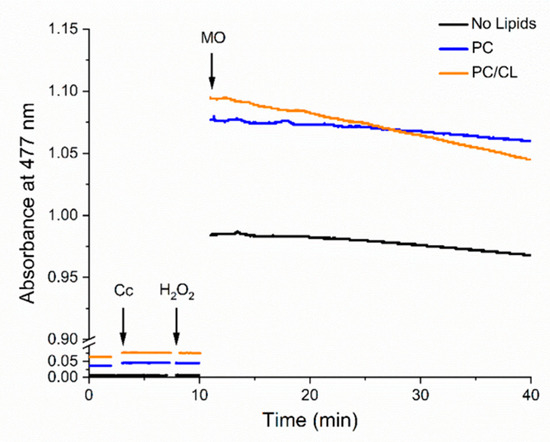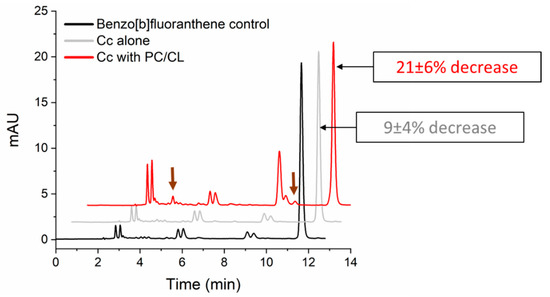Abstract
Cytochrome c (Cc) is well-known as an electron carrier at mitochondria but can also catalyze peroxidase-like reactions. Although the reported catalytic abilities are low, the role of Cc in transforming environmental toxicants requires additional studies. We employed cardiolipin vesicles to stimulate the enzymatic activity of Cc and tested the catalytic system towards the dye methyl orange and the polycyclic aromatic hydrocarbons (PAHs) benzo[b]fluoranthene and benzo[a]pyrene. The results showed that cardiolipin-containing vesicles promoted dye decolorization and the oxidation of both PAHs by Cc, indicating that lipid membranes can be useful to further investigate Cc–mediated metabolism of toxicants.
1. Introduction
A recognized electron carrier at the mitochondrial respiratory chain, cytochrome c (Cc) is a hemeprotein that can also catalyze peroxidase-like reactions [1,2,3].
Cc can catalyze different oxidation and hydroxylation reactions of aromatic hydrocarbons and heterocyclic compounds but with low catalytic efficiency [4]. For example, the oxidation of polycyclic aromatic hydrocarbons (PAHs) was previously studied in systems containing 1 mM H2O2, conditions that cause fast auto-oxidation and inactivation of the enzyme [2,4].
On the other hand, the peroxidase activity of Cc can be enhanced by the protein chemical modification or interaction with amphiphilic structures [4,5]. Widely reported, vesicles containing anionic phospholipids such as cardiolipin (CL) increase the enzymatic activity of Cc in several folds [1,3]. The interaction of Cc with these vesicles induces conformational changes that lead to a gain in peroxidase activity by enabling easier access of H2O2 to the protein heme [2,3]. On this basis, we tested the hypothesis that CL vesicles (Figure 1) could be used to improve the study of Cc ability to metabolize environmental toxicants.

Figure 1.
Representation of (a) the molecular structure of cardiolipin and (b) detail of the polar part, and (c) a unilamellar vesicle.
To test this hypothesis, in this work, we used methyl orange, an azo dye model, and the PAHs benzo[b]fluoranthene and benzo[a]pyrene. Most azo dyes are toxic and refractory to conventional treatment processes [6]. PAHs are ubiquitous environmental pollutants with important toxic properties [7], and the metabolic transformation of benzo[a]pyrene is closely implicated in carcinogenicity [8].
2. Materials and Methods
2.1. Materials and Preparation of Lipid Vesicles
Benzo[b]fluoranthene was obtained from Tokyo Chemical Industry (cat. no. B2982) and benzo[a]pyrene from Sigma-Aldrich (B1760). Cc was from Sigma-Aldrich (equine heart, cat. no. C2506), phosphatidylcholine (PC) from Tokyo Chemical Industry (D4250) and CL from Avanti (710335P).
Small unilamellar vesicles composed of PC or mixtures of PC with CL at a 4:1 molar ratio were prepared as described in [1]. Chloroform stock solutions of the lipids were dried and resuspended in 20 mM phosphate buffer, pH 7.0. The small unilamellar vesicles were obtained by sonicating aliquots of the lipid suspension using a titanium-microtip-equipped Hielscher UP100H sonicator.
The lipid vesicles were added in a final concentration of 200 µM to the reaction media of the biotransformation assays described below.
2.2. Assays of Methyl Orange Decolorization
The effect of the lipid vesicles in Cc transformation of methyl orange was assayed with 10 mg/L of the dye in 100 mM phosphate buffer, pH 7.0. Cc was added at a final concentration of 0.01 mg/mL and H2O2 at 100 µM. The transformation of the azo dye was monitored by UV-Vis spectrophotometry at 477 nm.
2.3. Assays of Polycyclic Aromatic Hydrocarbons Transformation
The lipid vesicles’ effect on the Cc transformation of PAHs was studied with benzo[b]fluoranthene and benzo[a]pyrene in 24 h incubations. The initial concentration of the PAHs was 1 mg/L, Cc 0.01 mg/mL and H2O2 100 µM in phosphate buffer pH 7.0.
At the end of the incubations, the remaining PAHs and the formed reaction products were extracted using hexane and analyzed by reverse-phase HPLC. The chromatographic analysis was carried out in an Agilent 1100 system equipped with a C18 column, using a mobile phase of acetonitrile and water (85:15) at a 1 mL/min flux and detection at 266 nm.
3. Results and Discussion
As shown in Figure 2, Cc slowly transformed methyl orange in the presence of H2O2. The presence of the PC vesicles in the reaction media did not significantly affect the transformation kinetics. Still, the PC/CL vesicles clearly increased the rate of methyl orange decolorization by Cc.

Figure 2.
Representative assays of methyl orange decolorization catalyzed by cytochrome c in the absence of lipids and in the presence of phospholipid vesicles. Small unilamellar vesicles of phosphatidylcholine (PC) and of a mixture with cardiolipin (PC/CL) were tested. The concentration of cytochrome c (Cc) was 0.01 mg/mL, hydrogen peroxide 100 μM, and methyl orange (MO) 10 mg/L. Other experimental conditions are described in Methods.
In the case of the PAHs, the Cc-mediated oxidation was almost imperceptible (<15%), despite the high compound concentrations used in the assays (1 mg/L). In accordance with the results from the methyl orange assays, PC vesicles showed no effect in the Cc-catalyzed transformation of both PAHs.
Nevertheless, by including CL vesicles in the assay media, the transformation became evident from the decrease observed in the benzo[b]fluoranthene and benzo[a]pyrene chromatographic peaks and by the emergence of reaction product peaks in the chromatograms. Results from benzo[b]fluoranthene assays are shown in Figure 3.

Figure 3.
Representative chromatograms from assays of benzo[b]fluoranthene transformation catalyzed by cytochrome c (Cc) in the absence of lipids and in the presence of vesicles containing phosphatidylcholine and cardiolipin (PC/CL). A chromatogram from a control assay without cytochrome c is shown in the foreground. The decreases in the area of the benzo[b]fluoranthene peaks relative to the areas measured in the control assays are indicated in %. Chromatographic peaks detected only in assays with PC/CL vesicles are signaled with arrows. Experimental conditions of the assays are described in Methods.
Concerning benzo[a]pyrene oxidation, it reached 71 ± 2% in the presence of the CL-containing vesicles. Control assays were carried out with benzo[a]pyrene plus H2O2 and CL vesicles, in the absence of Cc, and the PAH concentration in the samples after incubation showed no significant difference relative to similar controls without CL. Overall, the results from control assays indicated that any Cc-independent oxidation of benzo[a]pyrene by H2O2 is negligible, even in the presence of CL.
4. Conclusions
Vesicles formed from a mixture of PC and CL consistently enhanced the Cc-mediated transformation of two different types of compounds with relevant toxicity, an azo dye and PAHs.
The results herein support the employment of lipid membranes as tools facilitating the future application of Cc in generating specific toxicants’ metabolites. It also encourages studies of the potential participation of lipid vesicles to promote Cc activity in distinct contexts.
Author Contributions
Investigation, J.M.L. and D.M.-d.-S.; writing—original draft preparation, J.M.L. and R.L.; writing—review and editing, P.A.V. and R.L.; supervision, R.L. All authors have read and agreed to the published version of the manuscript.
Funding
This research was funded by Fundação para a Ciência e Tecnologia (FCT—Portugal) through the research project PTDC/BIA-MIB/31864/2017. It was also funded by FCT—Portugal in the scope of the unit projects UIDP/04378/2020 and UIDB/04378/2020 (UCIBIO), LA/P/0140/2020 (i4HB), LA/P/0045/2020 (ALiCE), UIDB/50020/2020 and UIDP/50020/2020 (LSRE-LCM).
Institutional Review Board Statement
Not applicable.
Informed Consent Statement
Not applicable.
Data Availability Statement
Data is contained within the article.
Conflicts of Interest
The authors declare no conflict of interest.
References
- Lagoa, R.; Samhan-Arias, A.K.; Gutierrez-Merino, C. Correlation between the potency of flavonoids for cytochrome c reduction and inhibition of cardiolipin-induced peroxidase activity. BioFactors 2017, 43, 451–468. [Google Scholar] [CrossRef] [PubMed]
- Barayeu, U.; Lange, M.; Méndez, L.; Arnhold, J.; Shadyro, O.I.; Fedorova, M.; Flemmig, J. Cytochrome c autocatalyzed carbonylation in the presence of hydrogen peroxide and cardiolipins. J. Biol. Chem. 2019, 294, 1816–1830. [Google Scholar] [CrossRef] [PubMed]
- Alvarez-Paggi, D.; Hannibal, L.; Castro, M.A.; Oviedo-Rouco, S.; Demicheli, V.; Tórtora, V.; Tomasina, F.; Radi, R.; Murgida, D.H. Multifunctional Cytochrome c: Learning New Tricks from an Old Dog. Chem. Rev. 2017, 117, 13382–13460. [Google Scholar] [CrossRef] [PubMed]
- Vazquez-Duhalt, R. Cytochrome c as a biocatalyst. J. Mol. Catal. B Enzym. 1999, 7, 241–249. [Google Scholar] [CrossRef]
- Maiti, S.; Das, K.; Dutta, S.; Das, P.K. Striking Improvement in Peroxidase Activity of Cytochrome c by Modulating Hydrophobicity of Surface-Functionalized Gold Nanoparticles within Cationic Reverse Micelles. Chem.—A Eur. J. 2012, 18, 15021–15030. [Google Scholar] [CrossRef] [PubMed]
- Berradi, M.; Hsissou, R.; Khudhair, M.; Assouag, M.; Cherkaoui, O.; El Bachiri, A.; El Harfi, A. Textile finishing dyes and their impact on aquatic environs. Heliyon 2019, 5, e02711. [Google Scholar] [CrossRef] [PubMed]
- Abdel-Shafy, H.I.; Mansour, M.S.M. A review on polycyclic aromatic hydrocarbons: Source, environmental impact, effect on human health and remediation. Egypt J. Pet. 2016, 25, 107–123. [Google Scholar] [CrossRef]
- Lagoa, R.; Marques-da-Silva, D.; Diniz, M.; Daglia, M.; Bishayee, A. Molecular mechanisms linking environmental toxicants to cancer development: Significance for protective interventions with polyphenols. Semin. Cancer Biol. 2022, 80, 118–144. [Google Scholar] [CrossRef] [PubMed]
Publisher’s Note: MDPI stays neutral with regard to jurisdictional claims in published maps and institutional affiliations. |
© 2022 by the authors. Licensee MDPI, Basel, Switzerland. This article is an open access article distributed under the terms and conditions of the Creative Commons Attribution (CC BY) license (https://creativecommons.org/licenses/by/4.0/).